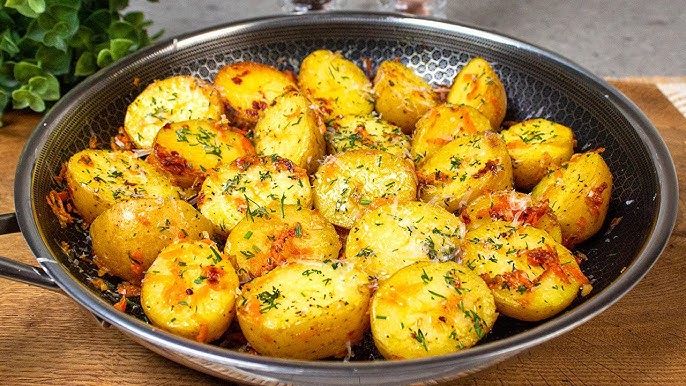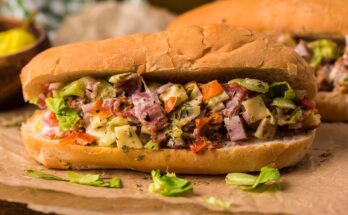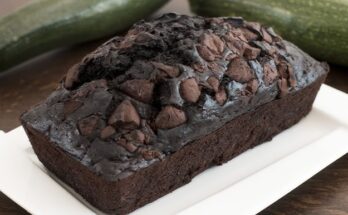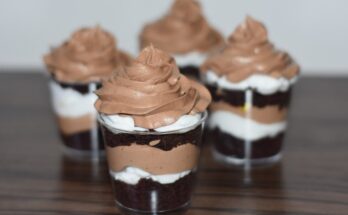Potato Recipe: Potatoes aren’t just another vegetable—they’re practically a global phenomenon. From the hearty Irish shepherd’s pie to Indian spicy aloo curries and crispy American fries, potatoes have found a home in nearly every cuisine. And it’s not just because they’re budget-friendly (though that definitely helps). Their mild, comforting taste and ability to absorb flavors make them the perfect blank canvas in the kitchen.
Think about it: how many other veggies can be mashed, roasted, fried, baked, grilled, or turned into soup and still taste amazing? Potatoes are the ultimate food chameleons. Whether you’re serving a holiday feast or whipping up a quick weekday dinner, a good potato recipe always hits the spot. Their long shelf-life, wide availability, and variety (Yukon Golds, Russets, Reds, and more) add to their universal appeal.
Health Benefits of Potatoes
Let’s bust a myth real quick: potatoes are not unhealthy. It’s all about how you cook them. When prepared mindfully, potatoes are a wholesome food packed with essential nutrients. They’re an excellent source of vitamin C, potassium (even more than bananas), vitamin B6, and fiber—especially when eaten with the skin on.
Potatoes also contain antioxidants and resistant starch, which improves gut health and helps manage blood sugar levels. Plus, their high satiety index means they help you feel full for longer, reducing the chances of overeating.
So, whether you’re meal prepping or feeding a crowd, potatoes offer the rare combo of being delicious, versatile, and nutritious.
Ingredients You’ll Need
Main Ingredients
To make a classic potato dish, you don’t need much. Here’s a basic list that covers the essentials:
- 4-6 medium-sized potatoes (Russet or Yukon Gold are ideal)
- 2 tablespoons olive oil or butter
- Salt and pepper to taste
- 2 cloves of garlic (minced, optional)
- Fresh herbs like rosemary, thyme, or parsley (optional)
Whether you’re roasting, boiling, or pan-frying, this core ingredient list stays pretty much the same. The only thing that changes? The method—and the magic.
Optional Add-ons and Variations
Want to level up? These extras can completely transform your potato recipe:
- Shredded cheese (cheddar, mozzarella, parmesan)
- Sour cream or Greek yogurt for creaminess
- Chopped scallions or chives
- Bacon bits or crumbled sausage
- Paprika, chili flakes, or Cajun seasoning
- Lemon juice or zest for a zingy finish
Feel free to get creative. Potatoes are super forgiving and play well with bold and subtle flavors alike.
Tools and Equipment Required
Basic Kitchen Tools
The great news? You don’t need fancy kitchen equipment to make killer potatoes. Here’s what you should have on hand:
- Cutting board and sharp knife
- Large mixing bowl
- Peeler (if you prefer skinless potatoes)
- Baking sheet or frying pan
- Tongs or spatula
- Measuring spoons
These basics cover you for most cooking methods—boiling, frying, baking, or sautéing.
Optional Gadgets for Efficiency
If you want to step up your game and make things easier or faster, consider:
- Air fryer: For crispiness without the extra oil
- Mandoline slicer: For uniform slices or chips
- Food processor: Great for making mashed or whipped potatoes
- Potato ricer: For ultra-smooth mashed potatoes
- Pressure cooker or Instant Pot: For faster boiling or steaming
None of these are must-haves, but they do make your life easier—especially when cooking for a crowd or doing meal prep.
Step-by-Step Instructions to Make Perfect Potatoes
Step 1 – Wash and Prep the Potatoes
First things first—clean your potatoes. Even if you’re peeling them, washing is a must to remove dirt and any residual pesticides. Use a vegetable scrubber under cold running water. For rustic dishes like roasted potatoes or wedges, keep the skin on for extra flavor and texture.
Next, decide how you want to cut them. Here are a few popular styles:
- Cubes: Great for roasting or soups
- Slices: Ideal for scalloped potatoes or gratins
- Wedges: Perfect for oven fries
- Whole: For baked or boiled potatoes
- Mashed-ready chunks: Ideal for faster boiling
Try to cut your pieces as uniformly as possible. This helps everything cook evenly and ensures consistent texture throughout.
Step 2 – Choose Your Cooking Style (Baked, Fried, Boiled, or Mashed)
Now that your potatoes are prepped, it’s time to pick your cooking method. Each style brings out different flavors and textures, so the choice depends on what you’re craving.
Baked Potatoes
This method gives you fluffy insides and crispy skins. Here’s how:
- Preheat your oven to 400°F (200°C).
- Prick each potato a few times with a fork.
- Rub with olive oil and sprinkle with salt.
- Bake directly on the oven rack for 45-60 minutes.
The result? Crispy skin with a soft, pillowy center. Slice them open and add toppings like butter, cheese, bacon bits, or sour cream.
Fried Potatoes
If you want golden, crispy perfection, this is it.
- Heat oil in a skillet over medium-high heat.
- Add thinly sliced or cubed potatoes.
- Season with salt, pepper, and herbs.
- Cook for 15–20 minutes, flipping occasionally.
Crispy on the outside and soft inside. Add garlic near the end to avoid burning.
Boiled Potatoes
Best for potato salads or as a side for grilled meats.
- Place potato chunks in a pot and cover with cold water.
- Add a pinch of salt.
- Bring to a boil, then simmer for 10–15 minutes until fork-tender.
Boiled potatoes soak up dressings and sauces beautifully.
Mashed Potatoes
Creamy comfort food at its best.
- Boil peeled chunks until very soft.
- Drain and mash with butter, warm milk, salt, and pepper.
- Add extras like cream cheese, roasted garlic, or herbs for more flavor.
Tip: Don’t overmix—mashing too much can make them gluey.
Step 3 – Seasoning for Flavor Boost
Here’s where the magic really happens. A good seasoning blend turns average potatoes into something unforgettable.
Basic Seasoning Mix
- Salt and pepper
- Garlic powder
- Onion powder
- Olive oil or melted butter
Toss your potatoes in this mix before baking, frying, or roasting.
Advanced Flavor Combos
- Smoky: Paprika + cayenne + garlic powder
- Italian: Dried oregano + basil + parmesan
- Spicy: Chili powder + cumin + crushed red pepper
- Herby: Fresh rosemary + thyme + sea salt
Experiment freely. Potatoes are like flavor sponges—they absorb spices and oils incredibly well.
Step 4 – Cooking the Potatoes to Perfection
You’ve seasoned them—now it’s time to cook. Whichever method you chose earlier, remember these golden rules:
- Don’t overcrowd the pan or baking sheet. Give each piece space to crisp up.
- If baking or roasting, use high heat (400–450°F).
- Flip or stir halfway through cooking for even browning.
- Taste-test often, especially when boiling or frying.
Cooking times can vary based on the size and type of potato. Keep an eye on texture and color. A well-cooked potato should be golden, tender, and lightly crispy.
Step 5 – Serving and Garnishing Ideas
Presentation matters—even with potatoes. Here are some fun and flavorful ways to serve them:
Topping Ideas
- Chopped herbs (parsley, dill, or chives)
- Shredded cheese or cheese sauce
- Crumbled bacon or sausage
- Sour cream or Greek yogurt
- Hot sauce, ranch, or aioli drizzle
Plating Suggestions
- Serve roasted potatoes alongside grilled meats or eggs.
- Mashed potatoes pair beautifully with stews or roasts.
- Load baked potatoes with toppings for a full meal.
- Fried potato slices or wedges are excellent with dipping sauces.
Let your creativity take the wheel. Potatoes can be dressed up or down depending on the occasion—weeknight comfort or weekend dinner party.
Tips to Elevate Your Potato Recipe
Common Mistakes to Avoid
Even though potatoes are simple to cook, a few common mistakes can ruin your dish. Here’s what to watch out for:
1. Skipping the Wash
Always wash potatoes thoroughly—even if you’re peeling them. Dirt, pesticides, and bacteria can linger on the surface.
2. Uneven Cuts
Cutting potatoes into uneven sizes leads to uneven cooking. You’ll end up with some overcooked mushy bits and some hard, undercooked ones. Use a sharp knife or mandoline for consistency.
3. Overcrowding the Pan
When baking or roasting, crowding the pan causes potatoes to steam instead of crisp. Always spread them out in a single layer.
4. Underseasoning
Potatoes are naturally bland. If you don’t season them properly, they’ll taste flat. Be generous with salt, pepper, herbs, and spices.
5. Using the Wrong Potato Type
Different recipes call for different potatoes:
- Russet for baking and mashing
- Yukon Gold for roasting and soups
- Red potatoes for salads and boiling
Using the wrong type can affect texture and taste.
Flavor Combinations That Work Like Magic
Some flavors just click with potatoes. Whether you’re keeping it classic or getting adventurous, try these combinations:
- Garlic + Butter + Parsley: A simple yet rich trio perfect for any potato style.
- Cheddar + Bacon + Chives: Classic baked potato toppings that never fail.
- Paprika + Cayenne + Lime Juice: For a smoky-spicy twist.
- Dijon Mustard + Honey + Rosemary: Great for roasting with a tangy flair.
- Lemon Zest + Dill + Greek Yogurt: Perfect for light, refreshing potato salads.
Don’t be afraid to mix and match. Once you learn what flavors complement each other, the possibilities are endless.
Nutritional Value of Potatoes
Despite their starchy reputation, potatoes offer a solid nutritional profile—especially when you prepare them right.
| Nutrient | Amount (per 100g boiled potato) |
|---|---|
| Calories | 87 kcal |
| Carbohydrates | 20 g |
| Protein | 2 g |
| Fat | 0.1 g |
| Fiber | 1.8 g |
| Vitamin C | 19.7 mg (33% DV) |
| Potassium | 379 mg (11% DV) |
Health Highlights
- High in Potassium: Helps regulate blood pressure.
- Vitamin C Boost: Supports immune function and skin health.
- Low in Fat: Great for weight management—when not fried.
- Filling and Satisfying: Helps reduce hunger between meals.
- Gluten-Free: Safe for people with celiac or gluten sensitivities.
To keep them healthy, avoid overloading with cream, cheese, or oil. Bake, boil, or steam with a light drizzle of olive oil and fresh herbs for a tasty, balanced side dish.
FAQs about Potato Recipes
What are the best types of potatoes for baking?
For baking, you want spuds that hold their shape and offer a fluffy texture. Russet potatoes are the gold standard for baking due to their thick skin and starchy content. They crisp up beautifully on the outside while staying light and airy on the inside.
How can I make my mashed potatoes creamier?
The key to creamier mashed potatoes lies in the choice of potato and the mixing technique. Use Yukon Gold potatoes for their naturally creamy texture. After boiling, add warm cream and melted butter, then mash until they’re silky smooth. Avoid over-mixing to prevent them from becoming gluey.
Can I make potato recipes healthier?
Absolutely! Consider swapping out some traditional ingredients for healthier alternatives. Use olive oil instead of butter, or try a dollop of Greek yogurt instead of sour cream. Incorporating fresh herbs and spices can also enhance flavor without extra calories.
Are there quick potato recipes for busy weeknights?
Yes, there are plenty of quick potato recipes. Try diced potatoes in a skillet with some olive oil, garlic, and your favorite herbs for a quick roast. Alternatively, microwave whole potatoes for about 5-8 minutes for a speedy baked potato.
What unique potato dishes can surprise my guests?
To wow your guests, venture beyond the usual dishes. Prepare a potato tart tatin for a savory twist on a classic dessert, or make a batch of sweet potato gnocchi for a comforting, impressive dinner. Another great option is loaded potato skins with unique toppings like blue cheese and walnuts or sun-dried tomato and pesto.
Conclusion
Potatoes are like that best friend who gets along with everyone and fits in everywhere. Whether you’re whipping up a cozy dinner, trying a new flavor combo, or just need something quick and filling—potatoes are the answer. Their versatility, affordability, and ability to absorb flavors make them one of the most beloved ingredients in kitchens across the world.
By following this step-by-step guide, you can master the art of cooking potatoes in all their glorious forms—crispy, creamy, savory, spicy, and everything in between. So grab a bag of spuds and get cooking. Your perfect potato dish awaits.



